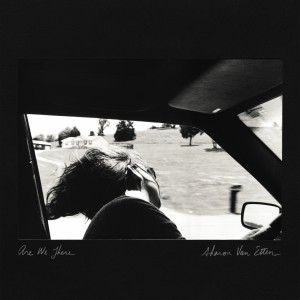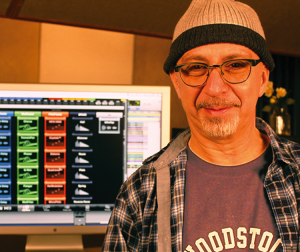Stewart Lerman on Sharon Van Etten, Modern Big Band, and What Makes Good Studios Great
Stewart Lerman has spent a good share of the last 5 years working with some major artists, far outside of their natural element.
Performers like Elvis Costello, Patti Smith, St. Vincent, Regina Spektor, Neko Case, Sharon Van Etten, Liza Minelli, Rufus Wainwright and David Johansen have all joined Lerman in some of New York’s biggest and most historic studios to sing live-in-the-room with a 1920’s-style big band, for the critically acclaimed HBO series, Boardwalk Empire, which is now entering its 5th and final season.
“When they come in, they’re usually a little nervous at first,” he says. “So few people working today have sung this way. But when you look at it, jazz really was the rock and roll of that era. And when they come and work with us, it’s like two hours, and the record is done! They love it. By the end of the date, they want to come down to the club afterwards and sit in with the big band.”
Working so quickly takes a lot of prep, and not only on Lerman’s part as producer and head engineer. He brings on pro arrangers, and a seasoned group of players called Vince Giordano & The Nighthawks.
“With the bands I’m working with,” he says, “if you can’t get it in two or three takes, then the arrangement is wrong — scratch it, and start again. Vince prepares these charts in advance, so we usually know it’s right when we’re going in, and there’s just not that many big decisions that have to be made on the date. You can think about the performance instead, and how it should sound, and how it will all affect the scene.”
Assistants Rule the Roost
Lerman also relies on studio assistants to help execute his vision and keep sessions running smoothly.
“The best studio in the world can be rendered completely useless without the right assistants,” he says. “I often book my sessions at studios based on where they have these young guys and gals who are just awesome at what they do. Places like Avatar, Sear Sound, Electric Lady — they have these kids who are like wizards.
“Once I’ve done a couple of dates at one of these places, everything is photographed, written up, measured with tape, so that if I have a similar session, I could show up 30 minutes before start time and everything is set up to my specifications. I don’t have to show up three hours early to blow out the mics.”
“It makes a big difference” Lerman adds. “I mean, we love gear, we love what we do, but the act of getting a performance — that’s the height of it all. If you’re in there futzing around with gear, if you’re losing your eye on the performer, you’re in trouble. I just can’t thank these guys enough — I’m a big fan of assistant engineers.”
Of course, there are some sessions where these huge studio spaces, built to handle well over a dozen musicians at once, might be overkill. In these cases, Lerman often finds himself working out of his own home base, Hobo Sound, which he shares with musician/producer Tony Shanahan, just across the Lincoln Tunnel from his Manhattan home.
Here, he’s worked with The Roches, Antony and the Johnsons, Crash Test Dummies, Marshall Crenshaw, Patti Smith, Gabriel Kahane, and recently, as co-producer on Sharon Van Etten‘s latest, Are We There, due out May 27, 2014 on Jagjaguwar.
Producing Sharon Van Etten’s Are We There
Just like Lerman, Van Etten and her band were living in Manahattan and the boroughs, making the “reverse commute” to take advantage of the low overhead costs across the water.
“We’d bump into each other at Port Authority, grab a cup of coffee, and we’d all be at work in 5 minutes,” Lerman says. “In 15 minutes, it would be nose to the grindstone.”
Unlike Boardwalk Empire, “a record like Sharon’s record is not on paper,” he adds. “She might bring in a song, and we’ll work on arrangements together. When I’m producing like this, I’ll often work with another engineer, so James Frazee might be in helping me out with the sessions.”
“For this record, we actually did two distinctly different ways. Sharon came to me and said she really wanted to try her hand at producing. She’s an incredibly talented multi-instrumentalist, and really wanted to dig in more on that side.
“So we did two run-throughs: One with her band, where I kind of fooled her. I told her we were going to do some ‘pre-production’, but I knew damn well we were going to get some real tracks — because I only know one way to record, and that’s to set up like you were going to record for real!
“After we spent some time recording the band and getting some tracks that we really loved, she wanted to try her hand at doing it all herself. So she played guitar, bass, drums, and if we needed to, we’d bring in other people to embellish here and there as we went along. So that record is really half the band, and half her. And I don’t think you could tell which half is which. She is a force of nature.”
Like so many of his projects these days, Lerman mixed most of Are We There at Hobo Sound, which is equipped with a classic Electrodyne desk and a Chandler sidecar, as well as his own extensive collection of mics and outboard gear.
New Music, New Media
Even with the recent declines in music sales, Lerman has still been keeping busy here and at larger spaces with his recording projects. It’s just that more and more of them have been coming from the commercial, film and TV worlds in recent years.
Some of them can be as rewarding as any record. He’s frequently worked on soundtracks for movies like The Aviator, The Grinch, Royal Tenenbaums, The Life Aquatic, and School of Rock with music supervisor Randall Poster. More recently, he provided all the backing tracks for a Super Bowl spot performed by The Muppets’ band, Dr. Teeth and Electric Mayhem.
“When you get a call from the muppets,” he says, “you’re not going to say no.”
Even in his straight music-only projects, Lerman has seen the influence of labels wane. His first sessions with Sharon Van Etten back in 2012 were commissioned by Starbucks, rather than a traditional record company.
“They pretty much gave us free reign,” he says. “When you pick two great artists like Sharon and Rufus [Wainwright] to collaborate with each other, you kind of stay out of the way.”
“I have very little input from record companies these days, too” he says. “A lot of people make their records without them now.” Sometimes for better, sometimes for worse.
“Even when they are involved, most record companies are not A&R-ing the way they used to. And you know what? There’s something to be said for their involvement, depending on who they might be.”
“The potential liability there is that they’re just looking to sell widgets, and they just want something that’s palatable, and that they can sell without to much fuss. But the thing I miss about it is that when I was first coming up, there were some really great A&R guys who were dope music listeners. They were often producers themselves.
“I came up with a couple of guys, like Rick Chertoff, who were just amazing producers and taught me so much about songs — About getting away from the technical side of it, and about getting into the craft of songwriting; into understanding what a lyric can do.”
Tech Turns Tables
It’s not all that’s changed in the 35 years Lerman has been making records in and around New York. He’s seen vinyl disappear and then come back again:
“I really dig that it slows people down and makes them really listen,” he says. “My only issue is that I don’t remember anyone ever sitting down in the studio going ‘Man, I can’t wait til this hits vinyl!’ Back then, everyone was like: ‘when this hits vinyl, we’ve got to make sure it doesn’t get f*d up!’ “I remember when the concept of CDs came along, it was like: ‘Wow, there’s going to be no surface noise, and you won’t have to worry about the sound quality of the inside tracks, and the needle bouncing around?’”
He’s also seen more than one studio revolution come and go:
“I came in to the studio world in the late 70s, as a guitar player who was fascinated with technology. When I started, you couldn’t really make a recording unless you had a record deal and the finances to go into a full blown recording studio. There weren’t all these cool little places like there are now. They just did not exist.”
“But right when I was starting out, TEAC came out with a little 1/4” 4-track, and that blossomed into Fostex 16 track 1”, and people started making these little consoles, and all of a sudden, you could get multitrack equipment. Me and a buddy of mine, who had moved out to LA for a while and learned how to build studios, partnered up on a 16 track machine, and found this little dumpy room on 30th Street to rent. We invited a few of our fellow musicians who knew a little bit about carpentry, built this studio, and pretty soon another buddy, who got this gig as an A&R guy with Columbia Records, comes over and says: ‘This cool. Can I rent is for a couple of months?’ And we were like ‘Really? Sure!’” He started bringing in Bryan Adams, Patty Smyth, all these people making records in the early 80s. And the next thing you know we were getting a really nice Trident desk and a nice Otari 2” machine.”
“There was really a scene here at the time,” Lerman says. “Punk was happening, New Wave was happening. At CB[GB]s you had Talking Heads, Patti Smith, Blondie, The Ramones, Television, Tom Verlaine and those guys. You had the folk scene on Bleecker Street, and at The Bottom Line. I used to wash dishes at The Bottom Line, and in ’78, ’79, it was like that place was exploding. I’d go see almost every show. My job didn’t start until midnight, washing the dishes, so I’d see Springsteen or George Benson or Suzanne Vega or The Roches or Loudon Wainwright, while I was just waiting around. Within a few blocks there was a phenomenal music scene,” he says.
“I don’t know really what happened to that. I guess times change, and it seems like the soil is fertile in Brooklyn. Let’s hope it thrives.”
Justin Colletti is an audio engineer, educator and journalist.
Please note: When you buy products through links on this page, we may earn an affiliate commission.









